Hanes Chwarela -
Diwydiant Llechi FFestiniog.
THE
SLATE INDUSTRY
OF
FESTINOG
(N. Wales)
With the Compliments of
The Associated Slate Quarries
The Slate Industry
of North Wales
The Festiniog Slate Quarries
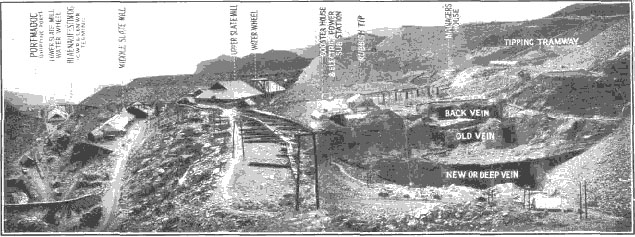 |
| Composite bird's-eye
view of a Festiniog Slate Quarry
(diagrammatic section), showing
order of slate veins. |
Although commonly spoken of as "
slate quarries," the Festiniog [Ffestiniog]
group in
Merionethshire are actually slate mines
worked on the underground principle of
alternate openings, locally termed chambers,
and walls or supporting pillars of solid
slate. In this they differ from their sister
workings in Caernarvonshire, which are
mostly of the open kind and consist of a
series of terraced steps ; somewhat
analogous in lay-out to the old Roman
amphitheatres.
The dip of the slate veins at Festiniog [Ffestiniog],
at an average of 30° from the horizontal,
in hilly country, necessitates the winning
of the slate rock by burrowing below the
surface in order to follow the course of the
slate-producing strata, and some of the
lowest workings are as much as 1,500 ft. or
more down. As will be readily understood,
the outlay in driving the adits, or as is
more usual to-day, in sinking inclines on
the angle of dip of the slate vein, and
horizontal levels at 50 to 60 ft. vertical
intervals, from which to open out the
chambers where the slate blocks are
produced, together with the accompanying
cost of haulage, compressed air equipment
for drilling, and pumping to keep the
workings clear of water, is very great.
There are advantages and disadvantages in
underground quarrying as compared with open
working. On the one hand, the open slate
quarries are liable to stoppage or to having
their operations slowed down in bad weather
by snow, frost and rain, and suffer from the
necessity to remove heavy " overburden
" ; on the other hand, having once
removed the overburden, they are able to win
100 per cent. of the slate rock. Whereas, in
the Festiniog [Ffestiniog] slate mines one must have 40
per cent. to 50 per cent. of exploitable
slate ungotten in the pillars supporting the
mine, though, to counterbalance this the
total tonnage mined is very much less for
every ton of actual slate produced, and
inferior rock need not always be removed.
THE SLATE-BEARING
STRATA
The slate-bearing strata of Festiniog [Ffestiniog]
belong
to the Ordovician or Lower Silurian systems,
and are of an uniform soft blue-grey colour,
although the North Vein or topmost bed shows
a tendency to be slightly darker. The
chemical analysis of a standard Festiniog [Ffestiniog]
slate shows silica 55 per cent., alumina 25
per cent., iron oxide 11 per cent., the
remainder being composed of various elements
of which the chief is magnesia. The lime
contents - an excess of which often
characterises an inferior slate - are
negligible.
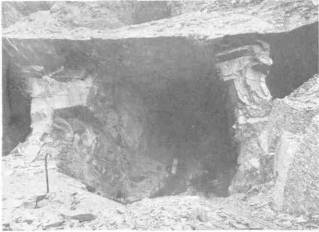 |
| Entrance to underground
workings, showing slate chamber and
pillar left in position to support the
superimposed mountain. |
The finely-developed cleavage allows the
slate rock to be split into amazingly thin
laminae by hand-for instance, a strip only
1/6 ins. thick can be split into 26 strips, a
remarkable tour de force and example of
extreme manual craftman-ship. A unique
feature of Festiniog [Ffestiniog] slate is its
resilience, which permits of one of these
strips 3 ft. long or more, only 1/20-in.
thick, being bent this way and that as a
similar strip of steel. Indeed, if it were
possible to obtain delicate enough tools,
the slate rock could be split even thinner.
Clever quarrymen make fans out of a solid
piece of rock, beautifully turned out in
fretwork designs, capable of opening and
shutting like the real article. Such
properties yield a roofing slate of unique
elasticity and strength, and it is the
possession of these two qualities, combined
with chemical inertness and its inability to
absorb moisture, which enables the Festiniog [Ffestiniog]
slate to yield a roofing material of ample
strength and great durability when split to
a thickness of no more than 1/6 in. This is
borne out by the following figures, the
result of a number of tests :-
Tensile strength, 8,470
Ibs. per sq. in.
Resistance to compression, 31,431 Ibs.
per sq. in. ; |
and a Festiniog [Ffestiniog] slate, 12 ins. wide, 1/6
in. thick, placed on supports 22 ins. apart,
load applied at centre, yielded :-
Mean ultimate load, 166
Ib. ;
Mean maximum deflection, .54 in |
A Festiniog [Ffestiniog] slate is also
practically non-absorbent, as, after being
dried and then immersed for 24 hours, showed
the remarkably low figure of 0.016 per cent.
absorption by weight.
The several slate deposits worked at Festiniog [Ffestiniog]
are of considerable thickness,
often from 150 ft. up to as much as 300 ft.,
measured on the horizontal, inter-stratified
with beds of chert and other rocks of
superior hardness to the workable slate.
These slate veins or beds are known in their
ascending order as the New or Deep Vein, the
Old Vein, Back or Middle Vein, and North
Vein. In addition, there is the Manod Vein
under the New or Deep Vein again, but this,
at present, is only being worked to quite a
small extent.
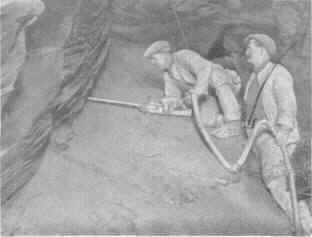 |
| Quarrymen drilling
underground on the cleavage or bedding
plane with a pneumatic hammer drill
for insertion of explosive charge. |
MINING THE SLATE
The following description of Festiniog [Ffestiniog]
slate mining methods, evolved through
several generations, gives a clear idea of
the standard practice adopted and followed
to-day in Festiniog [Ffestiniog], and was written by Mr.
E. Andrewes, A.M.Inst.C.E., for The
Sheffield University Mining Magazine.
" The normal process of opening up
and working one of the veins has been as
follows. Access is first obtained by means
of an adit level which, if circumstances
permit, would in the first instance be
driven under the overlying hard of the vein.
Otherwise it will be driven to reach the
hard and then continued as a drift along it.
From this level chambers are opened in an
upward direction, at appropriate intervals
under the hard. To appreciate fully the
process of opening and working the chambers,
it is necessary first to detail some
features of the slate rock. That essential
feature, the cleavage, approximately
coincides in strike with the bedding of the
slate, but has a somewhat steeper dip, so
that the cleavage planes cut the hard at a
slight angle. An equally constant feature of
the Festiniog [Ffestiniog] slate beds is what is known as
the ' pleriad ' or ' pillaring.' This
consists in a tendency in the rock to rend
with comparative readiness and regularity
along a plane at right angles to the
cleavage and with vertical dip. The slate is
also cut by frequent joints, which lie at
various angles, but some of the principal of
which, and the most helpful in quarrying
operations, strike and dip approximately at
right-angles to the bedding cleavage. All
these attributes of the slate rock are made
use of in quarrying.
" In opening a chamber, the first
operation is to drive in the slate what is
known as a roofing shaft upwards under the
hard, following the direction of the
pillaring. The roofing shaft having been
driven a certain distance, the next
operation, called widening, is the cutting
out of the top layer of the slate for the
full width of the chamber. The whole process
so far is in the nature of development work,
and is carried on by men classed as miners,
who use some form of dynamite as an
explosive.
" These are now followed by rockmen,
who carry out the actual quarrying
operations, and use gunpowder for charging
the holes. Their function is to quarry the
rock in blocks suitable for working up in
the slate mills, with as little waste and
injury to the good rock as possible. They
must begin by working a ' free side ' to the
rock. This is done by cutting a vertical
slice on the right-hand side of the chamber,
unless some natural feature of the rock
offers an advantageous opportunity of doing
it elsewhere. Having achieved a free side,
it is necessary also to obtain a free end to
the rock before a block can be quarried.
Convenient joints may supply this, but as a
rule a certain amount of cutting away of
rock, in the -form of a trench traversing
the width of the chamber, has to be done.
Where the rock is ' large ' (i.e., has no
joints) near the foot of a chamber, a
channeller is used for cutting free bottom.
" The quarrying of a block can now
be commenced. This is accomplished by
driving a splitting hole along the cleavage,
and a pillaring hole at right-angles to it,
and firing them in turn with a suitable
charge of gunpowder. The holes are placed
about half-way between the free bottom and
the next joint. The latter may be anything
from a couple of feet to twenty feet or more
from the free bottom, but a single hole
properly charged will ' run ' for the whole
of such a distance, and if the cleavage and
pillaring are good, very clean and regular
blocks are produced. It will be readily
understood that there is scope for a
considerable degree of skill and judgment on
the part of the rockman in placing and
charging his holes.
" When one chamber has been worked
far enough forward to clear the level, the
latter is driven further forward and another
chamber started in due course. The distance
normally allowed, measuring at right-angles
to the line of pillaring, for a chamber and
pillar is 85 ft. Of this width, 45 ft. would
be chamber and 40 ft. pillar. But in actual
practice there is a good deal of variation,
which may be due either to the roof not
being solid enough to permit of a chamber
being opened to the full width of 45 ft. or
to a fault or other irregularity in the
ground making it inadvisable to open a
chamber in a certain position.
" We have so far dealt with the
opening and working of a single level or
floor only, but as soon as such a floor is
fairly launched and has a chamber or two at
work, steps would be taken to open a floor
below it. This, in the initial stage of
development of a quarry, was sometimes done
by driving another adit level from the
surface, but the days are long past when
such a course was feasible, and the new
level has to be reached by sinking.
" The method adopted has been to
sink an incline shaft under the chert
overlying the Narrow Vein. A floor is then
opened on the new level in the same manner
as described above, care being taken that
the chambers on this floor line up with
those above. The process is continued
downward on succeeding floors, the final
result being, as regards any particular
chamber that, where conditions permit, the
whole of the slate rock is removed, and it
becomes one continuous excavation from floor
to floor. The quarry, in fact, becomes a
series of alternate chambers and pillars, or
walls.
" Where more than one slate vein is
worked in the same area, the work goes on
simultaneously in each vein, the walls and
chambers in each vein being kept in
alignment and superimposed. This, of course,
entails careful surveying, but is a very
essential feature of sound working. All the
principal slate mines in Festiniog [Ffestiniog]
have
suffered to some extent from falls (subsidences
on a large scale), which in some cases have
had disastrous results as regards the future
working of the quarries. These falls have
been caused chiefly by careless and
unsystematic working in past years. Chambers
have been made too wide, where profitable
slate was to be found, and pillars in some
cases well-nigh obliterated. The stability
of the ground has further often been
adversely affected by total lack of care as
to the placing of the chambers and pillars
in one vein vertically above and in
alignment with those in a vein above or
below it."
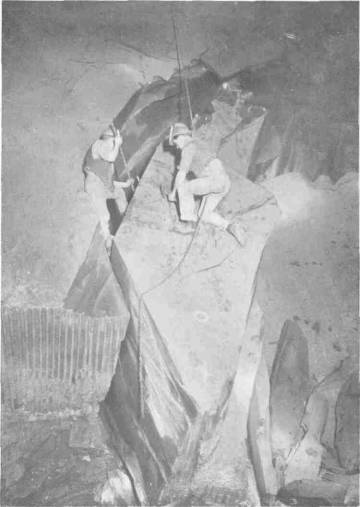 |
| A 20-ton block of solid
slate rock. |
The slate blocks won in the rough are
next hauled to the surface, often by
electric or mechanical traction on the flat,
and up the inclined haulages, whence they
are transported similarly to the mills, and,
after being first split into convenient
slabs, usually 3 to 4 ins. thick, are placed
on circular saw tables where they are
reduced to dimensions suitable for
man-handling by the splitter. Having been
split to the appropriate thickness for
roofing purposes, the still unshaped slate
is passed to the " dresser," who
puts it though a power-driven revolving
knife dressing machine, from which it
emerges in the true rectangular form so well
known to the trade and public, and
characteristic of English roofing slate
practice. Variations in size are obtained by
means of a graduated gauge on the dressing
machine.
Slate mining and production is thus seen
to be a most highly-skilled occupation, with
a special technique of its own, and one
which is largely hereditary, being carried
on by generations of slate quarrvmen, who
grow up with the instinctive " knack
" or " flair " which no mere
training can give, nor machines reproduce ;
an outstanding example of real
craftsmanship.
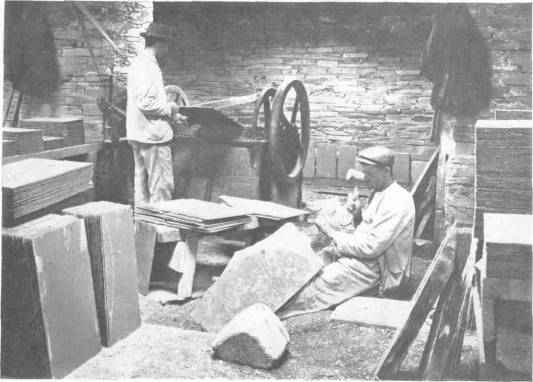 |
| A splitter and dresser
at work. |
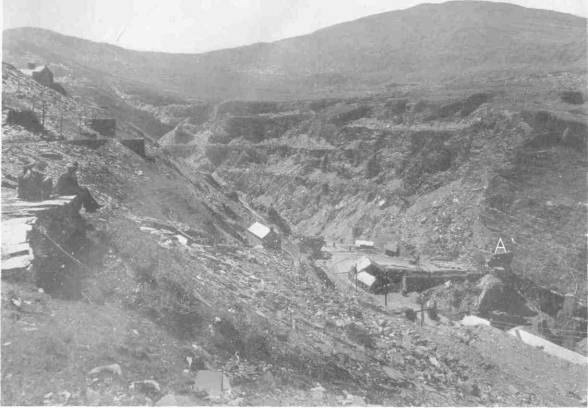 |
| Bird's-eye view of a Festiniog [Ffestiniog]
slate quarry showing old
surface workings, and main entrance to
mine at A. |
Festiniog [Ffestiniog] slate, by reason of its light
weight, unique qualities and high
non-conductivity, has found its way to all
parts of the globe-Iceland, Russia, South
and East Africa, Nigeria, South America,
Australia and New Zealand, to mention but a
few-while on the Continent many important
buildings are roofed with it, notably the
Hotel de Ville at Brussels, Hamburg
Cathedral, and Peace Palace at The Hague.
Apart from the manufacture of roofing
slates, slate is widely used for billiard
table beds, monumental purposes, brewery
tanks, aquariums, electric switch panels,
flat slate roofs (common in America) and
pavements, and even for " honing "
razors, slate giving the finest cutting edge
possible, while three years ago a secret
process was discovered and patented by
members of the Festiniog [Ffestiniog] group, as a result
of long research, by means of which slates
can be treated most satisfactorily by a
colouring process, by which the most
delightful pastel shades, hitherto
unobtainable in any roofing material, may be
obtained. Exotic tints such as peacock blues
and greens, are also available ; in fact,
they can be coloured or tinted to suit each
architect's or user's individual taste, in a
single colour or in any desired combination
of colours and shades. These coloured slates
withstand the action of boiling in acids and
alkalies up to and beyond twice normal
concentration. Mineral, or earth, colours
are alone used and these withstand treating
to very high temperatures. By a chemical
action, definitely beneficial to the slate,
the colour film becomes practically part and
parcel of the slate surface, hardening it
and becoming harder and more permanent with
age.
PRINCIPAL QUARRIES
The principal quarries in the Festiniog [Ffestiniog]
group are the Oakeley-incorporating the Votty
& Bowydd Quarries the Maen Offeren -
incorporating the Rhiwbach-the
Llechwedd (Messrs. J. W. Greaves & Sons,
Ltd.), the Manod and the Craig Ddu Quarries.
Up-to-date machinery, usually electrically
driven, is used. Great care and expense are
involved in keeping workings clear of water,
an important item where the average annual
rainfall varies between 80 and 170 ins.
The slates are entrained at Blaenau Festiniog [Ffestiniog], which centre is served by both the
London, Midland & Scottish and Great
Western Railway Companies, and at Minffordd
Junction (G.W.R.) and shipped coastwise or
abroad at Portmadoc [Porthmadog], whither they
are taken by a wonderfully constructed narrow
gauge railway laid in the early part of last
century on the 2-ft. gauge-at the time the
pioneer of all narrow-gauge railways, on which
was modelled later the Darjeeling railway in
India, and many others.
In conclusion, a good Welsh slate is the
"Rolls Royce" of roofing materials,
and being a natural rock must necessarily be
more lasting than any artificially produced
substitute, however good. It cannot be
mass-produced, nor adulterated, but remains
constant in quality and durability. A genuine Festiniog [Ffestiniog]
slate will easily outlast the
building it covers, and there are many
instances of its re-use on new buildings after
removal from very old buildings on demolition.
While admittedly not as cheap initially as
some artificial " roofers," on the
basis of the real cost of a roof, namely, the
initial cost plus maintenance costs over a
period of sixty years or more, it is "
facile princeps," maintenance costs being
practically negligible, always provided
suitable nails are used. It can be said, with
truth, that the first cost is the last cost,
and now that the only objection to its use,
that of a tendency to drabness- more often
than not caused by a lack of imagination and
suitable architectural design rather than to
any fault of the slate itself-no longer holds good, and
the universal cry for colour and yet more
colour can be aesthetically met, slate should
come, and is coming, once more into its own,
and taking pride of place as of yore.

|
| A length of solid slate
opened out into many laminae, thus
showing the extreme resiliency of this
material. |
OUTPUT OF SLATES. While slates are sold by
number and covering capacity their output is
usually expressed in tons, and to give some
idea of this, the present output of Festiniog [Ffestiniog]
slate is round about 40,000 tons per annum,
equivalent probably to at least 32,000,000
actual slates in the various standard sizes,
24 ins. by 14 ins. to 10 ins. by 6 ins., or
(say) 1,500,000 square yards of slating at 3
in. lap. All British material, produced by
British labour - and it is up to the British
public to insist on having their houses
covered with them to their own and their
children's children's lasting satisfaction.
It is no idle boast that good Welsh slates
are the finest and most lasting roofing
material, but a proved and indubitable fact,
as evidenced on every side and in every part
of the world, for everyone to see for
themselves.
It may be of interest to our readers to
know that in the Festiniog [Ffestiniog] group's largest
slate mine there are more than 30 miles of
tram roads, of which one-half are probably
underground, and it would take a good walker
several days to go through all the workings.
Air pipe-lines run into many miles ; as also
do electric cables. A hearty welcome is also
extended to any who may be in the vicinity of
Blaenau Festiniog [Ffestiniog], in North Wales, near the
centre of Snowdonia, to visit one or other of
the group's slate mines, and to see for
themselves their unique characteristics. We
can promise them an interesting and highly
instructive time, and a unique experience, for
they are to be counted among the modern
wonders of the world, the slate chambers being
easily the largest individual openings to be
found in any type of mining.
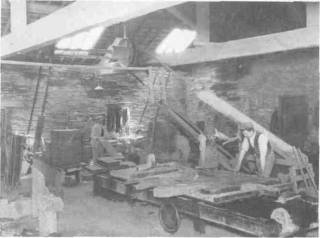 |
| A circular saw table at work. |
Printed by LOXLEY BROTHERS LIMITED, 50,
Southwark Bridge Road, London
Tarddiad: Building Times, 1936.
|